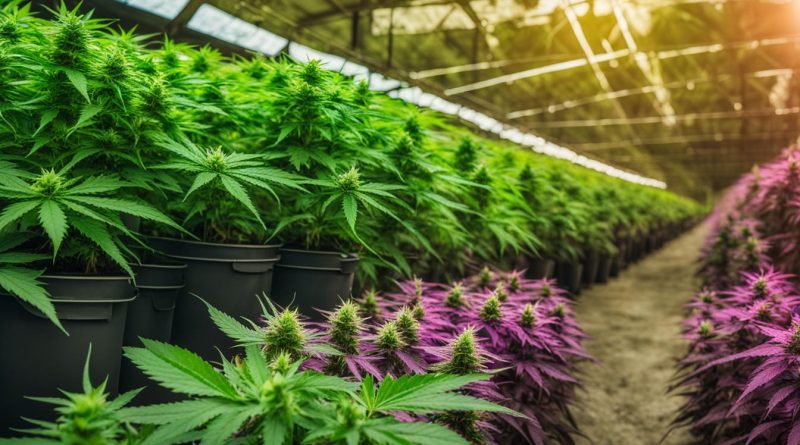Cannabis Industry’s Role in Sustainability
Welcome to our article on the cannabis industry’s role in sustainability! As the green revolution continues to gain momentum, it is crucial to examine the environmental impact of the cannabis industry and explore sustainable solutions for cannabis production. The rapid growth of the industry brings both opportunities and challenges, particularly in terms of energy consumption, water usage, and waste generation.
At the intersection of the cannabis industry and sustainability, we find a complex landscape. Due to federal prohibition, research on the environmental impact of cannabis production is limited. However, state regulators and companies are making efforts to address these challenges and promote sustainability within the industry. It is clear that more research is needed to develop and implement sustainable practices that can minimize the industry’s environmental footprint.
This article will delve into the various aspects of cannabis sustainability, including the environmental footprint of cannabis production, energy efficiency in cultivation, water conservation practices, waste management, the role of hemp in sustainability, and the adoption of sustainable practices within the industry. We will also discuss the challenges faced by the cannabis industry in its journey towards sustainability and explore the potential future trends and innovations that can shape a more sustainable industry.
Key Takeaways:
- The cannabis industry’s growth brings environmental challenges that need to be addressed.
- Energy consumption, water usage, and waste generation are significant concerns in cannabis production.
- Research on the environmental impact of the cannabis industry is limited due to federal prohibition.
- The adoption of sustainable practices and technologies can help minimize the industry’s environmental footprint.
- Promoting the use of hemp and exploring its potential can contribute to the sustainability of the cannabis industry.
Environmental Footprint of Cannabis Production
The production of cannabis has a significant environmental footprint, with energy consumption, water usage, and waste generation being key concerns. Cannabis production, especially indoor cultivation, requires a substantial amount of energy. Studies have shown that the energy consumption of indoor cannabis cultivation can be comparable to that of other energy-intensive industries such as data centers.
In addition to energy, water is also a crucial resource in cannabis production. The cultivation of cannabis plants requires irrigation, and improper water management can lead to excessive water usage and potential runoff, which can contribute to water scarcity and environmental pollution. Furthermore, waste generation in the cannabis industry is a growing concern, particularly with regards to packaging waste. Many cannabis products are packaged in single-use plastic, contributing to the global plastic pollution crisis.
It is essential to address the environmental impacts of cannabis production and develop sustainable solutions to minimize the industry’s carbon footprint. By implementing energy-efficient practices, such as the use of LED lights and renewable energy sources, the cannabis industry can significantly reduce its energy consumption. Moreover, adopting water conservation strategies, such as implementing efficient irrigation systems and water recycling, can help minimize water usage and mitigate the environmental impact of cannabis cultivation.
| Environmental Impact | Challenges | Sustainable Solutions |
|---|---|---|
| Energy Consumption | High energy requirements, especially in indoor cultivation | Use of energy-efficient practices, such as LED lights and renewable energy sources |
| Water Usage | Excessive water consumption and potential for runoff | Implementation of efficient irrigation systems and water recycling |
| Waste Generation | Significant packaging waste, including single-use plastic | Reduction of packaging waste and adoption of eco-friendly alternatives |
Energy Efficiency in Cannabis Cultivation
The energy usage in cannabis cultivation, especially in indoor facilities, is a significant concern when it comes to the environmental impact of the industry. The use of artificial lighting to provide the necessary light spectrum for optimal plant growth consumes a substantial amount of electricity. However, there are measures that can be taken to improve energy efficiency and reduce the carbon footprint of cannabis cultivation.
One of the key solutions is the adoption of LED lights, which offer several advantages over traditional high-intensity discharge (HID) lights. LED lights are more energy-efficient, producing higher light intensity per watt and generating less heat. They also have a longer lifespan, reducing the need for frequent replacements. By switching to LED lights, cannabis cultivators can significantly reduce their energy consumption and lower their operating costs.
However, retrofitting existing cultivation facilities with LED lights can be a costly endeavor, preventing some growers from making the switch. Additionally, the initial investment required for LED lighting systems may be a barrier for small-scale cultivators. In order to encourage widespread adoption of energy-efficient lighting, industry collaboration and financial incentives, such as grants or tax breaks, could be explored to support growers in transitioning to LED technology.
The Benefits of LED Lights in Cannabis Cultivation
Using LED lights in cannabis cultivation offers several benefits:
- Energy efficiency: LED lights consume less energy compared to traditional lighting systems, leading to lower electricity bills and reduced carbon emissions.
- Longer lifespan: LED lights have a longer operational life, resulting in lower maintenance costs and reduced waste from frequent bulb replacements.
- Heat management: LED lights produce less heat compared to HID lights, helping to maintain optimal temperature and humidity levels in cultivation facilities.
- Light spectrum control: LED lights can be customized to provide specific light spectra optimized for different stages of plant growth, improving overall plant health and productivity.
| LED Lights vs. HID Lights | LED Lights | HID Lights |
|---|---|---|
| Energy Efficiency | High | Low |
| Lifespan | Long | Short |
| Heat Generation | Low | High |
| Light Spectrum Control | Precise | Limited |
By prioritizing energy efficiency and adopting LED lighting systems, the cannabis industry can make significant strides towards reducing its environmental impact. Continued research, collaboration, and financial support are essential to further drive innovation and overcome the barriers to widespread adoption of energy-efficient practices in cannabis cultivation.

Water Conservation in Cannabis Cultivation
The sustainable use of water resources is a crucial factor in reducing the environmental impact of cannabis cultivation. Water usage in the cannabis industry is a concern due to potential runoff and contamination of nearby soil and water sources. Implementing water conservation practices can help mitigate these issues and promote more sustainable cultivation methods.
One effective water conservation practice in cannabis cultivation is the use of automated irrigation systems. These systems provide precise control over water delivery, ensuring that plants receive the optimal amount of water without waste. By avoiding overwatering and minimizing runoff, automated irrigation systems can significantly reduce overall water usage in cannabis cultivation.

Table: Comparison of Water Conservation Practices in Cannabis Cultivation
| Water Conservation Practice | Description |
|---|---|
| Drip Irrigation | This method delivers water directly to the base of each plant, minimizing wastage and preventing runoff. |
| Smart Irrigation Systems | These systems use sensors and weather data to adjust watering schedules, optimizing water usage based on plant needs and weather conditions. |
| Water Recycling | By capturing and reusing water runoff, growers can reduce overall water consumption and minimize the environmental impact of irrigation practices. |
| Xeriscaping | This landscaping technique involves using drought-tolerant plants and designing the cultivation area to minimize the need for excess water. |
Education and awareness among cannabis growers are essential for promoting water conservation practices. By understanding the environmental impact of water usage in cannabis cultivation and the benefits of adopting sustainable practices, growers can make informed decisions and actively contribute to water conservation efforts. Additionally, research and development in water-saving technologies specific to the cannabis industry can further enhance water conservation efforts in the future.
Waste Management in the Cannabis Industry
The cannabis industry, like any other industry, generates a significant amount of waste. This includes packaging waste, which is a growing concern for environmentalists. Many cannabis products are packaged in single-use plastic containers, contributing to plastic pollution and landfill waste. To address this issue, we need to develop better waste management practices and explore sustainable alternatives.

Table: Comparison of Packaging Waste in the Cannabis Industry
| Plastic Packaging | Alternative Eco-friendly Packaging | |
|---|---|---|
| Benefits | Commonly used and easily available | Environmentally friendly and recyclable |
| Environmental Impact | Contributes to plastic pollution and landfill waste | Reduces plastic waste and promotes sustainability |
| Challenges | Requires policy changes and industry collaboration | May have higher production costs initially |
Improving waste management in the cannabis industry requires a multi-faceted approach. First, we need policy changes to incentivize the use of eco-friendly packaging materials and reduce the reliance on single-use plastics. Second, industry collaboration is crucial in developing and implementing recycling programs specific to the cannabis industry. This includes creating infrastructure for proper collection, sorting, and recycling of cannabis-related waste. Finally, companies can take the initiative to explore innovative solutions, such as biodegradable packaging materials, to minimize the environmental impact of packaging waste.
By addressing the issue of waste generation in the cannabis industry and implementing sustainable waste management practices, we can significantly reduce the industry’s environmental footprint. This not only benefits the environment but also helps to build a positive image for the industry as a whole. As responsible participants in the cannabis industry, it is our collective responsibility to prioritize waste reduction and promote sustainable practices throughout the supply chain.
The Role of Hemp in Cannabis Sustainability
Hemp, a versatile and eco-friendly variety of cannabis with low THC content, plays a crucial role in promoting sustainability within the cannabis industry. Its numerous environmental benefits make it an attractive option for various industries seeking sustainable alternatives.
One of the remarkable applications of hemp is in the development of sustainable building materials, such as hempcrete. Hempcrete is a carbon-negative material made from a mixture of hemp, lime, and water. It is lightweight, durable, and has excellent thermal insulation properties, making it an ideal choice for green construction projects. By utilizing hempcrete, we can reduce the carbon footprint of the construction industry and contribute to a more sustainable future.
In addition to being used as a construction material, hemp can also be transformed into eco-friendly products such as hemp plastics and hemp paper. Hemp plastics are biodegradable and can be a sustainable alternative to traditional plastics, which contribute significantly to pollution and waste. Similarly, hemp paper production requires less chemical processing and water compared to traditional paper production, making it a more sustainable choice.
Overall, hemp offers a wide range of opportunities for sustainable innovation. Its versatile applications in various industries make it a valuable asset in our journey towards a greener future.

Hempcrete vs. Traditional Building Materials: A Comparison
| Hempcrete | Traditional Building Materials |
|---|---|
| Carbon-negative: absorbs CO2 | Carbon-positive: emits CO2 during production |
| Excellent thermal insulation properties | Lower thermal performance |
| Lightweight and durable | Heavier and less durable |
| Biodegradable | Non-biodegradable |
Sustainable Practices in the Cannabis Industry
The cannabis industry is actively adopting sustainable practices to minimize its environmental impact. By embracing regenerative farming techniques, implementing green packaging solutions, and harnessing solar energy, the industry is taking significant steps towards a more sustainable future.
Regenerative Farming
Regenerative farming practices are being embraced by cannabis cultivators to improve soil health, minimize chemical inputs, and enhance biodiversity. By employing techniques such as cover cropping, crop rotation, and integrated pest management, cannabis growers can create resilient ecosystems that support long-term sustainability.
Green Packaging
The cannabis industry is addressing the issue of packaging waste by exploring greener alternatives. By opting for eco-friendly materials and reducing unnecessary packaging, companies can minimize their environmental footprint. Sustainable packaging options such as recyclable glass containers and biodegradable materials are gaining popularity among environmentally conscious cannabis brands.
Solar Energy
The adoption of solar energy is another sustainable practice that is gaining traction in the cannabis industry. By harnessing the power of the sun, cultivators can significantly reduce their carbon emissions and energy costs. Solar panels are being installed in cultivation and processing facilities, allowing for cleaner and more sustainable energy production.
These sustainable practices, including regenerative farming, green packaging, and solar energy utilization, demonstrate the cannabis industry’s commitment to environmental stewardship. By implementing these practices, the industry is moving towards a more sustainable and ecologically responsible future.
| Sustainable Practices | Benefits |
|---|---|
| Regenerative farming | Improved soil health and biodiversity |
| Green packaging | Reduced packaging waste and environmental footprint |
| Solar energy | Lower carbon emissions and energy costs |
Addressing Climate Change in the Cannabis Industry
The cannabis industry has a unique opportunity to address climate change and reduce its environmental impact. As the industry continues to grow, it is crucial to implement sustainable practices that contribute to carbon sequestration and reduce carbon footprints. By adopting these practices, we can play a significant role in combating climate change and promoting environmental sustainability.
The Role of Carbon Sequestration
One way the cannabis industry can contribute to climate change mitigation is through carbon sequestration. Cannabis plants, including hemp, have the ability to sequester carbon from the atmosphere through photosynthesis. This natural process helps reduce greenhouse gas emissions and mitigate the effects of climate change. By cultivating cannabis and promoting the use of hemp-based products, we can harness the power of carbon sequestration and make a positive impact on the environment.
Minimizing Carbon Footprints
Reducing carbon footprints is another crucial aspect of addressing climate change in the cannabis industry. This can be achieved by implementing sustainable practices throughout the cultivation, processing, and distribution processes. Examples include using renewable energy sources such as solar power, optimizing energy efficiency in indoor cultivation facilities, and reducing waste and emissions. By prioritizing sustainability and minimizing carbon footprints, we can contribute to a greener future and protect our planet for future generations.
| Practices to Address Climate Change in the Cannabis Industry |
|---|
| 1. Implement renewable energy sources like solar power |
| 2. Optimize energy efficiency in cultivation facilities |
| 3. Reduce waste and emissions |
| 4. Promote the use of hemp-based products |
We have the responsibility to act as stewards of the environment. By addressing climate change and reducing our carbon footprint, we can contribute to a more sustainable future for the cannabis industry and beyond.
Addressing climate change in the cannabis industry requires a collective effort, including collaboration among industry stakeholders, policymakers, and consumers. By working together to implement sustainable practices and support research and innovation, we can pave the way for a greener future. Let us seize this opportunity to make a positive impact and ensure the long-term viability of the cannabis industry while protecting our environment.
Overcoming Challenges to Cannabis Sustainability
In order to fully embrace sustainability in the cannabis industry, we must confront and overcome several challenges that currently hinder our progress. Legal restrictions and policy limitations play a significant role in impeding the development of sustainable solutions. These barriers not only limit research funding but also hinder industry collaboration and innovation. However, by addressing these challenges head-on, we can pave the way for a greener and more sustainable future.
“Legal restrictions and policy limitations hinder the development of sustainable solutions in the cannabis industry.”
One of the key challenges we face is the federal prohibition on cannabis, which limits access to federal funding for research on sustainability. Without proper funding, it becomes difficult to conduct the necessary studies and gather comprehensive data to develop environmentally friendly practices and technologies for the industry. By advocating for policy changes that support research funding for cannabis sustainability, we can overcome this challenge and unlock the potential for innovation.
Industry collaboration is another crucial aspect that needs to be addressed. With a fragmented market and varying regulations across states, it can be challenging to establish unified sustainability standards and practices. By fostering collaboration among industry stakeholders, we can create a platform for sharing knowledge, best practices, and technological advancements. This collaboration will enable us to collectively work towards implementing effective sustainability strategies across the entire cannabis industry.
Collaboration Leads to Innovation
Research funding is crucial for driving innovation in the cannabis industry. By investing in research and development of sustainable cultivation methods, energy-efficient technologies, and waste management systems, we can identify and implement best practices. The insights gained from this research will enable us to optimize resource usage, reduce environmental impact, and ensure long-term sustainability.
To promote research funding, we need to engage with policymakers and educate them on the potential benefits of sustainable cannabis practices. By demonstrating the economic and environmental advantages of sustainability, we can encourage policy changes that prioritize and support sustainability initiatives within the industry.
“Industry collaboration is crucial for the development and implementation of sustainable strategies in the cannabis industry.”
Overcoming the challenges related to legal restrictions, policy changes, industry collaboration, and research funding requires a collective effort. As an industry, we need to come together, advocate for change, and actively seek out opportunities for collaboration. By working hand in hand, we can drive the adoption of sustainable practices, develop innovative solutions, and ensure the long-term viability of the cannabis industry.
Table: Current Challenges to Cannabis Sustainability
| Challenges | Description |
|---|---|
| Legal Restrictions | Federal prohibition limits research funding and hinders the development of sustainable solutions. |
| Policy Limitations | Varying regulations across states create challenges in establishing unified sustainability standards. |
| Industry Collaboration | A fragmented market makes it difficult to coordinate efforts and implement industry-wide sustainability practices. |
| Research Funding | Limited access to funding hampers research and the development of sustainable technologies and practices. |
The Future of Cannabis Sustainability
As the cannabis industry continues to evolve, the future holds great promise for sustainable innovations and environmental stewardship. We are witnessing a significant shift towards more environmentally conscious practices and a growing awareness of the need to minimize the industry’s impact on the planet. The coming years will be characterized by a focus on future trends that promote sustainability and ensure the long-term viability of the cannabis industry.
Exploring Sustainable Innovations
The future of cannabis sustainability lies in the development and adoption of innovative solutions that prioritize environmental responsibility. Research and development efforts are underway to explore sustainable cultivation techniques, such as regenerative farming practices that promote soil health and biodiversity. By embracing these innovations, the industry can reduce its carbon footprint and contribute to a greener future.
Environmental Stewardship as a Priority
Environmental stewardship will play a crucial role in shaping the future of the cannabis industry. Industry stakeholders are increasingly recognizing the importance of minimizing energy consumption, water usage, and waste generation. As sustainability becomes a core value, companies will invest in green technology, implement efficient recycling programs, and explore alternative packaging materials to reduce environmental impact.
Collaboration for a Sustainable Future
The future of cannabis sustainability depends on collaboration among industry players, policymakers, and researchers. By working together, we can establish best practices, set industry standards, and drive policy changes that support environmentally friendly practices. Additionally, increased research funding is needed to further understand the environmental impact of the cannabis industry and develop innovative solutions that promote sustainability.
| Future Trends | Sustainable Innovations | Environmental Stewardship |
|---|---|---|
| Regenerative farming | Exploring sustainable cultivation techniques | Minimizing energy consumption |
| Alternative packaging materials | Investment in green technology | Efficient recycling programs |
| Research and development | Reducing carbon footprint | Promoting collaboration and policy changes |
Conclusion
The cannabis industry has the potential to create a sustainable future for us and our planet. As we continue to navigate the challenges of energy consumption, water usage, and waste management, it is crucial that we prioritize sustainability and minimize our environmental impact. By adopting sustainable practices, we can be at the forefront of the green revolution.
Collaboration among industry stakeholders is key in driving positive change. By working together, we can advocate for policy changes that support sustainable practices in the cannabis industry. We also need increased research funding to develop innovative solutions and further our understanding of cannabis sustainability.
As we look ahead, our industry must embrace the opportunity to be environmental stewards. By investing in green technology and continuously improving our sustainability efforts, we can ensure the long-term viability of the cannabis industry and contribute to a more sustainable future.
FAQ
What are the environmental challenges of the cannabis industry?
The production of cannabis consumes a large amount of energy, water, and generates waste, including packaging waste. It also contributes to air emissions and potential air quality issues.
What is the impact of energy consumption in cannabis cultivation?
Cannabis cultivation, especially indoor cultivation, requires a significant amount of energy. LED lights can help reduce energy consumption, but retrofitting existing facilities and the high cost of upgrading can be barriers to energy efficiency.
How is water usage a concern in cannabis cultivation?
Cannabis cultivation uses artificial irrigation, which can lead to runoff and contamination of nearby soil and water sources. Implementing water conservation practices, such as automated irrigation systems and water reuse, can help reduce the environmental impact of water usage.
What is the waste generation in the cannabis industry?
The cannabis industry generates a significant amount of waste, including packaging waste. Many cannabis products are packaged in single-use plastic, contributing to plastic pollution and landfill waste.
How can hemp contribute to cannabis sustainability?
Hemp, a variety of cannabis with low THC content, has several environmental benefits. It can be used to create sustainable products such as hemp plastics, hemp paper, and hemp-based building materials like hempcrete, which is a carbon-negative material that can reduce the environmental impact of construction.
What sustainable practices are being adopted in the cannabis industry?
Sustainable practices include embracing regenerative farming techniques, using eco-friendly packaging materials, and adopting solar energy to reduce carbon emissions and energy costs in cultivation and processing facilities.
How can the cannabis industry contribute to climate change mitigation?
Cannabis plants, including hemp, can sequester carbon through photosynthesis, helping to reduce greenhouse gas emissions. By adopting sustainable practices and reducing carbon footprints, the cannabis industry can play a role in combating climate change.
What are the challenges to cannabis sustainability?
Legal restrictions and policy limitations hinder research and the development of sustainable solutions. Overcoming these challenges requires policy changes, industry collaboration, and increased research funding.
What does the future of cannabis sustainability look like?
Continued innovation and the adoption of sustainable practices are key. Ongoing research, investment in green technology, and collaboration among industry stakeholders are essential for further improving sustainability in the cannabis industry.
How can the cannabis industry prioritize sustainability?
By addressing energy consumption, water usage, waste management, and adopting sustainable practices, the cannabis industry can contribute to a greener future. Collaboration, policy changes, and increased research funding are necessary for progress in cannabis sustainability.













